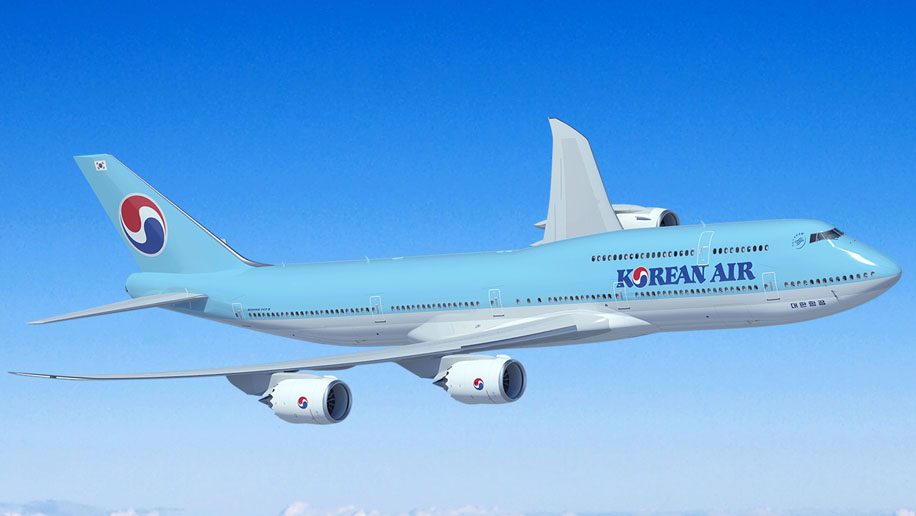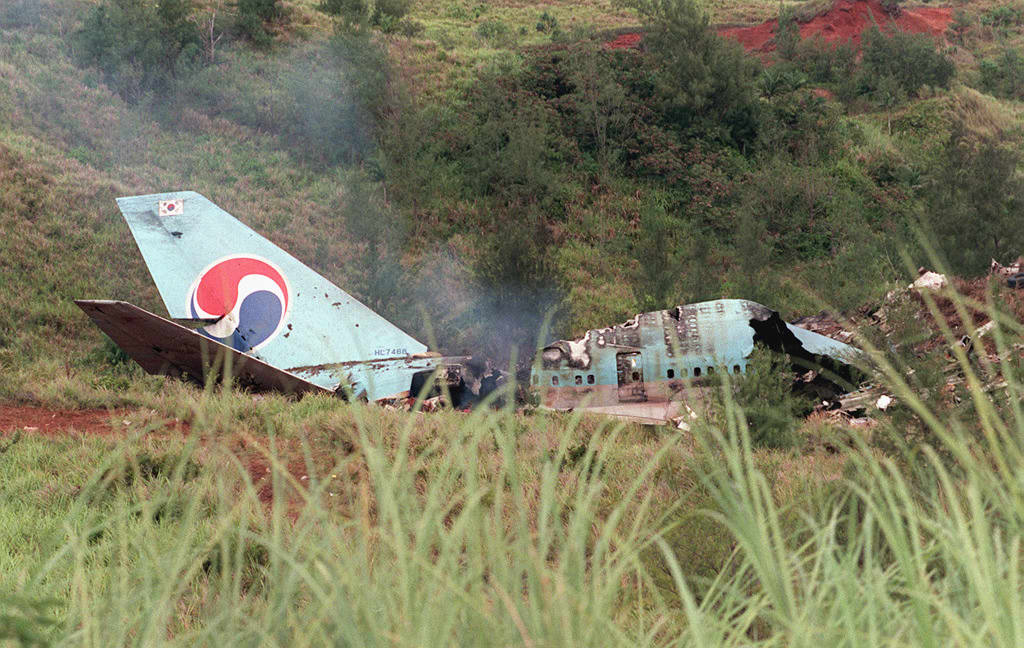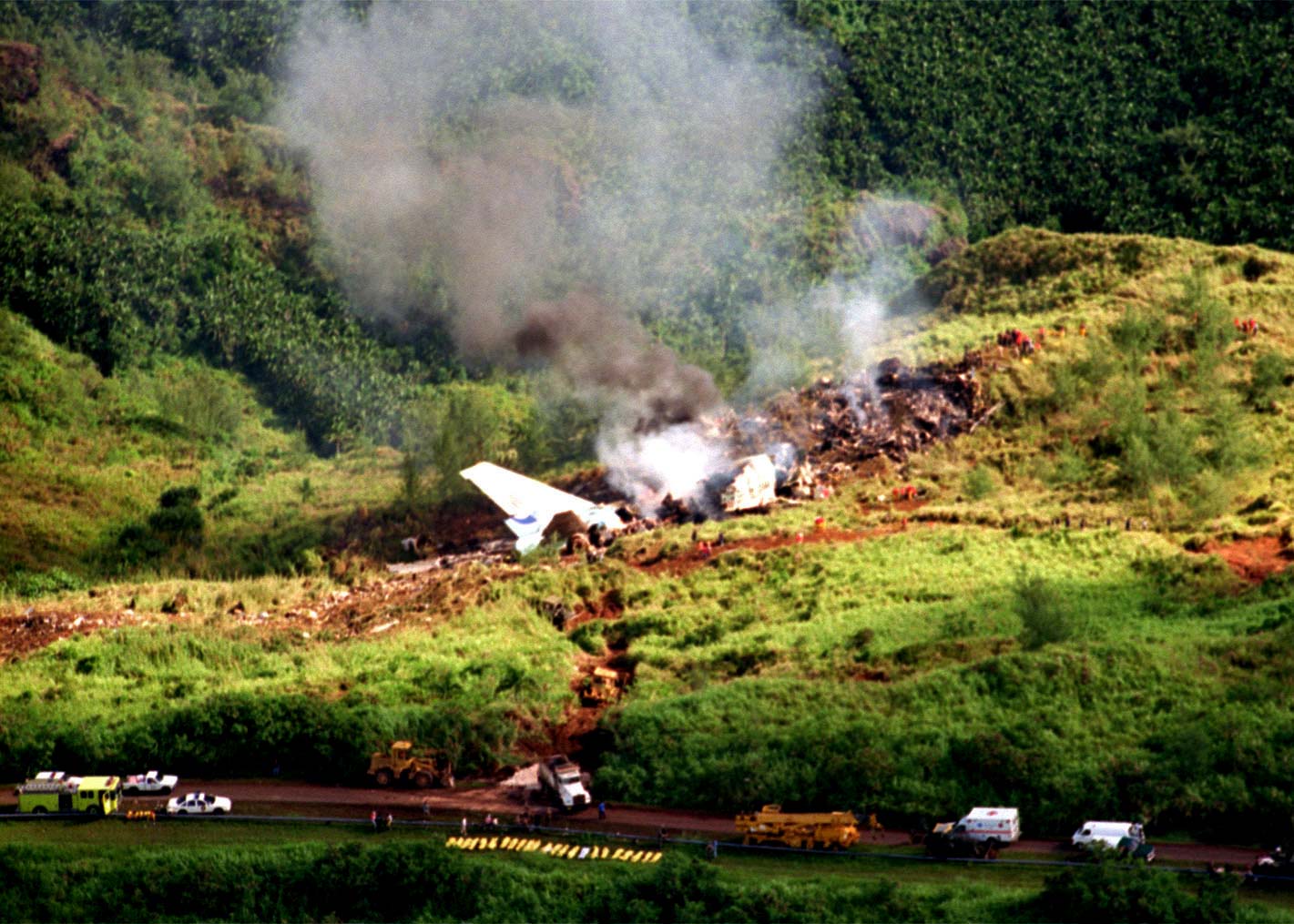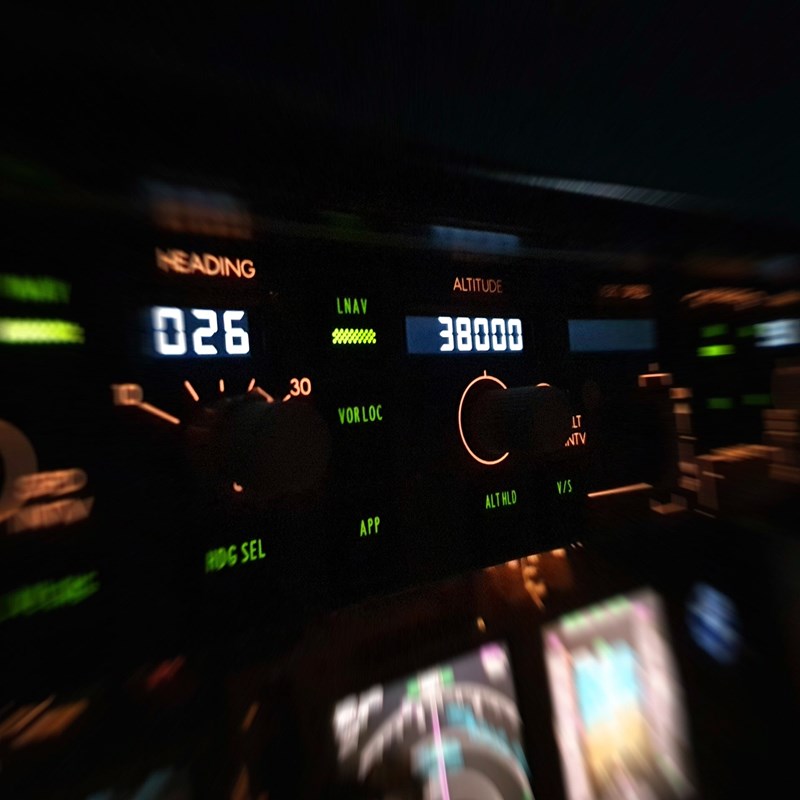6 August 1997 - Korean Air 801
Korean Air Flight 801 (KE801, KAL801) was a scheduled international passenger flight operated by Korean Air. The flight crashed on August 6, 1997, on approach to Antonio B. Won Pat International Airport, in the United States territory of Guam, killing 229[a] of the 254 people aboard. The aircraft crashed on Nimitz Hill in Asan-Maina, Guam, while on approach to the airport. The National Transportation Safety Board cites poor communication between the flight crew as probable cause for the air crash, along with the captain's poor decision-making on the non-precision approach.

Flight 801 departed from Seoul-Kimpo International Airport (now Gimpo International Airport) at 8:53 p.m. (9:53 p.m. Guam time) on August 5 on its way to Guam. The flight experienced some turbulence, but was uneventful until shortly after 1:00 a.m. on August 6, as the jet was preparing to land. There was heavy rain at Guam so visibility was considerably reduced and the crew attempted an instrument landing. The glideslope Instrument Landing System (ILS) for runway 6L was out of service. However, Captain Park believed it was in service, and at 1:35 am managed to pick up a signal that was later identified to be from an irrelevant electronic device on the ground. The crew noticed that the aircraft was descending very steeply, and noted several times that the airport "is not in sight." Despite protests from flight engineer Nam that the detected signal was not the glide-slope indicator, Park pressed on and at 1:42 am, the aircraft crashed into Nimitz Hill, slightly south of the community of Nimitz Hill Annex, about 3 nautical miles (3.5 mi; 5.6 km) short of the runway, at an altitude of 660 feet (200 m).

The U.S. National Transportation Safety Board (NTSB) investigated the accident.
A special weather observation made at 01:32, ten minutes before the impact, reported:
Wind 090° at 6 knots; visibility—7 miles; present weather—shower vicinity; sky condition—scattered 1,600 feet, broken 2,500 feet, overcast 5,000 feet [above ground level]; temperature—27° C; dew point—25° C; altimeter setting 29.85 inches Hg; remarks—showers vicinity northwest-northeast.
Another special weather observation made at 01:47, five minutes after the impact, reported:
Wind variable at 4 knots; visibility—5 miles; present weather—light rain shower; sky condition—few 1,500 feet, scattered 2,500 feet, overcast 4,000 feet; temperature 26° C; dew point 24° C; altimeter 29.85 inches Hg.
The crew had been using an outdated flight map that was missing a 724 foot obstruction symbol depicted at the NIMITZ VOR and that map stated the Minimum Safe Altitude while crossing the NIMITZ VOR for a landing aircraft was 1,300 feet (400 m) as opposed to the updated altitude of 1,440 feet (440 m). Flight 801 crashed near the NIMITZ VOR, which is situated on Nimitz Hill at a height of 680 feet (210 m) at 1:42 am, when it descended below the minimum safe altitude of 1,440 feet (440 m) during its landing approach. The report also identified that the captain may have mistakenly believed that the airplane was closer to the airport than it was and that there may have been confusion about the location of the Distance Measuring Equipment (DME) in relation to the airport, with the crew anticipating the VOR/DME to be located at the airport. The DME was sited at the NIMITZ VOR some 3.3 nmi (3.8 mi; 6.1 km) from the airport and such a configuration had not been part of Korean Air's simulator training, the crew's training for such non-precision approaches having been carried out in scenarios where the DME was located at the airport. Nevertheless, the correct DME distances were shown on the approach chart.
The NTSB was critical of the flight crew's monitoring of the approach, and even more critical of why the first officer and flight engineer did not challenge the captain for his errors. Even before the accident, Korean Air's Crew Resource Management program was already attempting to promote a free atmosphere between the flight crew, requiring the first officer and flight engineer to challenge the captain if they felt concerned. However, the flight crew only began to challenge the captain six seconds before impact, when the first officer urged the captain to make a missed approach. According to the cockpit voice recorder (CVR), the flight crew had suggested to the captain that he made a mistake, but did not explicitly warn him. The flight crew had the opportunity to be more aggressive in his challenge and the first officer even had the opportunity to take over control of the aircraft and execute a missed approach himself, which would have prevented the accident, but he did not do this. Despite examining Korean Air's safety culture and previous incidents, the NTSB was unable to determine the exact reasons why the flight crew failed to challenge the captain, but at the same time noted that "problems associated with subordinate officers challenging a captain are well known."
Air Traffic Control error also played a role in the accident. The approach controller, 39-year-old Kurt James Mayo, did not give a position advisory to the flight crew, which would have advised them to cross check their position on radar with that of other flight instruments. In addition, he was supposed to monitor the flight even after they switched to the tower frequency, which could have allowed him to alert the rescue response. Mayo did not monitor the flight on the terminal radar display which showed the terrain in the area because radar service had been terminated at the time. The tower controller, Marty Irvin Theobald (also 39), was also criticized for not alerting the crew, as Mayo had been unaware of the aircraft's low altitude, and did not provide an alert to him.
Special Link: Radar Data with selected ATC and CVR communication excerpts
Transcript of Air Traffic communications
LEGENDA:
Guam CERAP: CERAPAgana FCT, Local Control: LCKorean Airline Flight 801: KAL801Ramp Control: RAMPAndersen AFB Control Tower: Andersen
| 15.38.06 | CERAP | inbound |
| 15.38.12 | LC | agana tower |
| 15.38.13 | CERAP | twelve west korean air eight zero one seven forty |
| seven i I s six left k m | ||
| 15.38.18 | LC | understand seven four |
| 15.38.20 | CERAP | thats what i show |
| 15.38.22 | LC | all right thanks t o |
| 15.39.23 | CERAP | km |
| 15.41.07 | KAL801 | agana tower korean air eight zero one ah |
| (unintelligible) localizer six left | ||
| 15.41.14 | LC | korean air eight zero one heavy agana tower runway |
| six left---wind-zero niner zero at seven cleared to | ||
| land verify heavy boeing seven four seven tonight | ||
| 15.41.26 | KAL801 | korean eight zero one roger (unintelligible) six left |
| 15.41.30 | LC | korean eight zero one heavy roger |
| 15.44.02 | CERAP | was that nine eighty eight youre looking for |
| 15.44.07 | LC | say again |
| 15.44.09 | CERAP | guam to saipan is that nine eighty eight |
| 15.44.11 | LC | affirmative |
| 15.44.12 | CERAP | yeah i think we lost a flight plan so im just gonna |
| make one up here---oops | ||
| 15.44.18 | LC | ah he hadnt called me yet so they may not have |
| put it in either he may have they may have cancelled | ||
| it | ||
| 15.44.23 | CERAP | ok |
| 15.44.24 | LC | why dont we just hold off till he calls for it |
| 15.44.26 | CERAP | km |
| 15.44.28 | LC | to |
| 15.45.25 | LC | korean air eight zero one heavy tower how do |
| you hear | ||
| 15.47.03 | RAMP | this is juan |
| 15.47.05 | LC | yeah korean air eight zero one heavy ah---aircraft |
| change on the type is that a permanent change | ||
| 15.47.11 | RAMP | ah no thats just ah one of those temporary deals |
| 15.47.14 | LC | is that one of the temporaries |
| 15.47.15 | RAMP | yeah they they their normal is an airbus its just |
| i guess | ||
| 15.47.19 | LC | yeah |
| 15.47.19 | RAMP | they have more passengers this time around |
| 15.47.21 | LC | all right what gate is he on |
| 15.47.22 | RAMP | ah hes going to gate twelve |
| 15.47.23 | LC | all right thanks t o |
| 15.47.24 | RAMP | (unintelligible) |
| 15.48.05 | LC | korean air eight zero one heavy agana tower |
| 15.49.51 | RAMP | this is juan |
| 15.49.52 | LC | yeah korean air come up to you |
| 15.49.53 | RAMP | ah no |
| 15.49.54 | LC | all right thanks t o |
| 15.49.55 | RAMP | *(all right) |
| 15.49.56 | LC | approach agana |
| 15.50.15 | LC | korean air eight zero one heavy agana tower |
| 15.50.23 | LC | approach agana did korean air come back to you |
| 15.50.28 | CERAP | eight zero one |
| 15.50.29 | LC | affirmative |
| 15.50.35 | CERAP | no |
| 15.50.35 | LC | he checked in with me i cleared him to land i |
| dont know where hes at--never did have him in | ||
| sight | ||
| 15.50.41 | RAMP | you never saw him |
| 15.50.45 | CERAP | he didnt land |
| 15.50.46 | LC | negative |
| 15.50.50 | CERAP | oh my god |
| 15.50.52 | LC | stand by a second |
| 15.50.58 | RAMP | this is juan |
| 15.51.00 | LC | yeah did korean air |
| 15.51.01 | RAMP | no in fact im listening to cerap i dont even hear eight |
| zero one i can hear you on the radio | ||
| 15.51.06 | LC | yeah i tried to get a hold of him he called me ah |
| i cleared him to land | ||
| 15.51.09 | RAMP | yeah (unintelligible) |
| 15.51.10 | LC | i never had him in sight |
| 15.51.11 | RAMP | (unintelligible) you said cleared to land and i was |
| looking around and i said wheres he at and thats | ||
| when | ||
| 15.51.14 | LC | yeah i never had him in sight hold on a second |
| 15.51.17 | LC | andersen tower agana tower |
| 15.51.18 | CERAP | dont see him on the radar |
| 15.51.27 | LC | i dont see him either standby a second |
| 15.51.30 | Andersen | go ahead |
| 15.51.31 | LC | you didnt have a boeing seven forty seven land up |
| there did you | ||
| 15.51.35 | Andersen | just now |
| 15.51.36 | LC | affirmative |
| 15.51.37 | Andersen | hu hu ah no i dont have any lights on so i dont i dont |
| see anybody out there | ||
| 15.51.41 | LC | well we're missing a boeing seven forty seven stand |
| by | ||
| 15.51.45 | LC | just checked with andersen they dont know where |
| hes at either | ||
| 15.51.49 | CERAP | is it raining out there |
| 15.51.50 | LC | i got wet runway but ah--ive got a small ah shower |
| pushing through but i dont have ah but i can see the | ||
| approach end---standby a second | ||
| 15.52.04 | LC | korean air eight zero one heavy agana tower |
| 15.52.16 | LC | is that him talking to you |
| 15.52.19 | CERAP | negative |
| 15.52.26 | LC | i dont have him---he called me once i cleared him to |
| land told him not in sight and i dont have him | ||
| 15.52.34 | CERAP | well he must have crashed then |
| 15.52.38 | LC | korean air eight zero one heavy agana tower |
| 15.52.45 | CERAP | I'll talk to you later |
| 15.52.46 | LC | to |
| 15.52.47 | LC | you there---i do not have him---not in sight and i |
| have a shower pushing through the field now im | ||
| losing my visby | ||
| 15.53.22 | RAMP | (unintelligible) *(lost him) |
| 15.53.24 | LC | why we dont know where hes at we're still looking for |
| him | ||
| 15.53.27 | RAMP | what about cerap cerap |
| 15.53.28 | LC | center doesnt have him either he hasnt gone back to |
| center center doesnt have him on the radar | ||
| 15.53.33 | RAMP | yeah last time he was with you right he was about |
| what---ten out | ||
| 15.53.37 | LC | something like that |
| 15.53.38 | RAMP | yeah cause i heard you say you said not in sight but it |
| sound like he was already ten out or something---from | ||
| the time cerap let him go | ||
| 15.53.45 | LC | yeah um he hasn't called you on your frequency |
| 15.53.47 | RAMP | no |
| 15.53.48 | LC | all right thanks |
| 15.53.49 | RAMP | ok |
| 15.53.50 | LC | approach agana |
| 15.53.55 | CERAP | center |
| 15.53.56 | LC | yeah i just checked with ramp they a ah haven't i ya |
| he hasn't called them either | ||
| 15.54.02 | CERAP | well---he must have crashed then west of the airport |
| 15.54.08 | LC | he was what ah about twelve out when you gave him |
| to me ten or twelve out when you gave him to me | ||
| 15.54.12 | CERAP | yes |
| 15.54.14 | LC | o k i don't have him he's not on my frequency |
| 15.54.18 | CERAP | well i don't know how you can have--somebody |
| search west of the airport for the airplane | ||
| 15.54.25 | LC | whos that ah inbound |
| 15.54.27 | CERAP | I'll ask ryan |
| 15.54.28 | LC | thanks t o |
| 15.54.30 | LC | korean air eight zero one heavy agana tower |
| 15.55.10 | CERAP | tower center inbound |
| 15.55.13 | LC | agana tower |
| 15.55.14 | CERAP | six south ryan seven eighty nine visual runway six left |
| km | ||
| 15.55.17 | LC | is he gonna be able to go out and take a look |
| 15.55.19 | CERAP | yeah he's looking now |
| 15.55.26 | LC | thanks t o |
| 15.55.28 | LC | tower tower |
| 15.55.28 | RAMP | is that him behind you |
| 15.55.29 | LC | no thates ryan |
| 15.55.31 | RAMP | oh thates ryan coming in now |
| 15.55.32 | LC | affirmative |
| 15.55.33 | RAMP | o k ill (unintelligible) |


